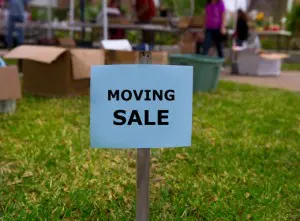Relieve yourself of moving unnecessary items by having a move sale and generate some money while doing it. Avoid unwanted stress with these helpful tips from Molloy.

- Making prior plans readies you for a successful sale, making you not to overlook anything. We recommend a minimum of three weeks for pre-planning.
- Confirm if there are any local administrative by-laws or other restrictions guiding move sales. Maybe some special permit is required, payment of a fee and/or collection of sales taxes. Check if advertising signs for such a sale are allowed.
- Collaborating with a few neighbors to hold a joint sale, combine efforts, share the fun and profits, may also be a good idea. Combining merchandise to have a larger assortment of goods to offer potentially attracts more buyers.
- Where will you hold your sale? In your yard, basement, patio? For a joint sale, a centrally-located place (e.g. a community area) may be a better option for all involved.
- Schedule a precise date/hours for your move sale. Holding it over the weekend and/or during warmer days may be your best bet. You may also have a traditional sales day in your community. In case of rain, make plans for an alternate sales date, and avoid holidays.
- To prepare for any injury eventualities, ensure your insurance agent is aware of your sale and confirm if your homeowners’ policy can cover you for such liabilities.
- For your shoppers’ convenience, save some cardboard boxes and shopping bags for packing.
2. Sorting Everything Out
- Once you have identified stuff you need to offload, collect them on one site and confirm that all are in the best shape for selling, and price-label them. Remember to do any small repairs as is necessary — sewing, addition of glue, simple nailings, etc. Such minor things could actually be the only thing between sales and leftovers.
- Go-togethers like a cake rack and pans can be bundled and sold in one package. You could also pack together some unrelated wares as grab-bag specials or surprise package.
- Ensure linens/clothing are washed, ironed, neatly folded, sizes clearly labeled, and packed (or put on hangers). Remember to pair shoes and label their sizes as well.
- In case of a joint sale, all goods should be labeled using an identifying code/color for each participant for easier identification and to avoid any conflicts over profits later.
- Once something is earmarked for sale, immediately attach a price tag on it and move it out to the central sale location. Never postpone the pricing process until very close to sale time. For dishes, attach price tags on the underside (rather than on top) to avoid ruining their patterns when removing the tag later.
3. Pricing
- Price your wares according to their actual value to the next consumer, not you the seller. 20-30% of original buying price for items in tiptop shape and good working order is a reasonable pricing. Books and used clothing typically go for less.
- For easier computations and figuring out of costs and change due, consider increments of 25 cents, 50 cents or whole dollars during pricing. Keep in mind that once in a while your customers will expect you to go down on some prices, but NOT up.
- During pricing, remember the fact that you are selling used items, therefore price them accordingly. Look at them objectively and seek a happy medium (not too high nor too low) with sufficient room for some bargaining. You may have some exceptions for collectibles that you believe should fetch higher prices.
- For any item that no longer works or is defective, mark them AS IS and set a fair price. Put price tags on all articles and list down all pricing on a record sheet. To ease the process and avoid losing tags during sale, use press-on tags from office-supply/stationery stores. You could also cut masking tape into small pieces and use them for this purpose.
4. Advertising
For a successful and profitable sale, take it as if you were in any competitive marketplace operating any serious retail business — vigorous and aggressive ads packaged cleverly; use of a slogan on big signs; attaching of balloons; attracting of customers by playing up offbeat merchandise; etc.
To increase awareness about your sale:
- Run ads in your local dailies
- Announce your sale to club members in your neighborhood/community (Especially on Facebook or other social media)
- Put up signs/notices in windows/bulletin boards of stores in your locality
- Slip a notice into your church/school newsletter or newspaper
- Have signs put up in your neighborhood a day prior to the sale, with one LARGE one at the sale location
- Signs should have BIG, BOLD and CONSPICUOUS lettering (for instance, black lettering on white/yellow background). Also include date/time and address of sale
- Keep the appearance of directional signs consistent to avoid your would-be customers attending another sale in the neighborhood due to sign confusion
- If some buyers arrive the night before or one hour prior to your actual start-of-sale timing, do not get surprised; some may just want to look around. In this case, you may have to make a decision if you will be starting selling any goods before your posted start-time
- Once the sale is done, do not forget to take down all your sale signs, announcements and notices
5. The Displays
- Do not arrange your merchandise before removing any items not meant for sale from the sales location. Any heavy immovable items should be covered using a sheet, or drop cloth and put up on them large signs reading NOT FOR SALE.
- For linens/clothing, organize them by size. Also set up a rack for hanging apparel. For this purpose, a stretched clothesline across your garage area, or a ladder horizontally suspended from your ceiling could be used.
- For display, set up a temporary counter using boards placed across sawhorses. Aisles should be wide enough for easy passing by shoppers.
- Put and group together related merchandise. Smaller articles, CDs, records, books, etc. can be held using corrugated cartons and stood on end to enable easier flipping.
- If you can, have an extension cord for testing electrical appliances, and a tape measure for buyers to confirm size of furniture.
- Provide a mirror and temporary dressing room for clothes shoppers and have somebody check them in and out of it. Use numbered cards corresponding to articles of clothing shoppers are trying on to arrest shoplifting.
- Use signs corresponding to different sections of sale, e.g. Music, Books & Magazines; Housewares & Kitchen Gadgets; All Table 3 Items for $1; Surprise Grab Bags for $.25; etc.
6. Security Issues
- Never leave your sale unattended. Beware of unscrupulous people. If alone, they may take advantage to physically intimidate you. Normally, shoplifters work in twos; one distracting you while their colleague steals. Beware of such tactics.
- Rather than having a small box to keep cash in, consider wearing a money-belt for making change. But for large bills, keep them in the pocket.
- For shoppers who bring in shopping bags/other container, ask them to leave it with you till they have decided what to buy with it.
- Beware of anybody just loitering around, especially those who appear to be watching your movements.
- Small and easily concealable items should be displayed in an open easy-to-watch place, for instance checkout counter.
- If the move sale is happening around your home area, ensure all the doors of your residence are locked. If you own a cordless telephone, keep it away from buyers by taking it with you.
- To beat pilferers and shoplifters in their own game, follow any aimless loiterers and other suspects around asking them what they may be interested in buying and if they need any help. With this kind of close supervision, they will not get time and space to do their dirty tricks and will therefore leave.
7. Ready, Set… Go!
Prepare everything you will need for your sale beforehand (at least a day before) in order to be ready to go by your advertised kick-off time. You will require:
- Lots of loose change (including $1 bills). Get free coin rolls from your local bank and know the amount of change you have before your sale kicks off.
- Pencil and paper to make computing of costs easier. You may also need a calculator if charging of sales tax will be involved.
- A record sheet to enable you mark off items straightaway after selling them, and make necessary price changes.
- Old newspapers to wrap supplies, cardboard cartons and shopping bags, twine, stapler, and scissors/sharp knife, as well as trash can to maintain your sales site clean.
- Employ a strict CASH ONLY policy and have a big sign for it. If you have to accept any checks, then they have to be from people you know well.
- Set a deposit and time limit for anybody wanting an item held for them to pick later.
- Confine pets during sale; crowds or unfamiliar persons can make some become agitated while others may drive buyers away. Overzealous customers may also step on their paws.
8. Bargaining
- In anticipation of some bargaining from your shoppers, have your record sheet listed with the necessary price changes.
- Consider closing your sale with some discounts, more so on key items. A 10% rebate is a good starting point for this. For buyers who may want to start bargaining right away, inform them to return after lunch when you will be discounting all merchandise.
- Around the end of your move sale, consider lowering prices. Better less profit than many unwanted leftovers.
9. Post-Sale
- If it was a collaborative sale, divide up your profits and remember to less the amount with which you started.
- Since most banks will charge you for counting/rolling your loose coins, why not let your kids have some fun helping with that?
- Secure all collected cash in a safe place till you can deposit it in the bank.
- Be sure to get rid of all sales signs put up earlier.
- Finally, you may want to give out to charity (the Salvation Army, Goodwill, or a children’s home) any leftover merchandise. Such organizations will normally give you a donation receipt to enable the value to be deducted on your tax returns. You can also contribute them to a church rummage sale, school, community center or resale shop.
Congrats! You now have some extra cash, all from getting rid of stuff you did not want to carry with you to your new home. And didn’t you have some fun, too?
When you are ready for your move, be sure to call a New Jersey moving company you can trust.



